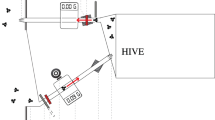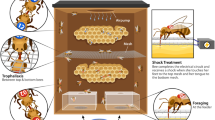Abstract
The interplay between the recruitment dance and food-giving trophallactic contacts of returning Apis mellifera foragers was analyzed. Dancing and trophallactic events were recorded for bees returning from a rate feeder that provided 50% weight on weight sucrose solution at a constant flow rate of 5 μl min−1. Bees that had danced immediately before their trophallactic contact had more recipients per trophallaxis compared with bees that did not dance before. Thus, besides information coded in dancing behavior, dance maneuvers could serve as a stimulus to increase attention of bees located on the dance floor to receive nectar. In addition, the number of bees receiving food during a trophallaxis showed a positive correlation with the probability of dancing immediately after contacting. The time from arrival at the hive to when the first or the subsequent contacts took place presented no correlation with the probability of dancing after trophallaxis. Also, the duration of a trophallaxis was positively correlated with the number of recipients per trophallaxis. These results suggest that returning foragers could receive information during a trophallactic contact with their hive mates that modify thresholds for dancing. Dance maneuvers and trophallactic contacts performed by foraging bees seem to be “mutually” affected.
Similar content being viewed by others
Author information
Authors and Affiliations
Additional information
Accepted: 29 November 1999
Rights and permissions
About this article
Cite this article
Farina, W. The interplay between dancing and trophallactic behavior in the honey bee Apis mellifera . J Comp Physiol A 186, 239–245 (2000). https://doi.org/10.1007/s003590050424
Issue Date:
DOI: https://doi.org/10.1007/s003590050424




